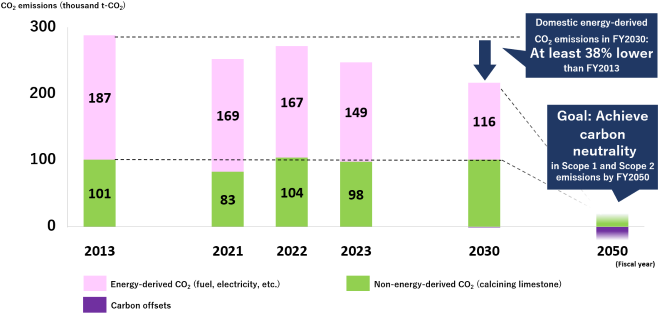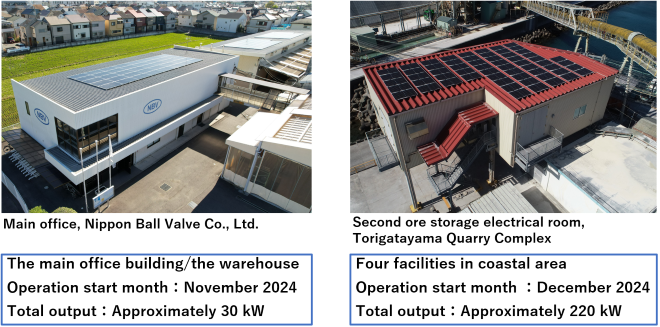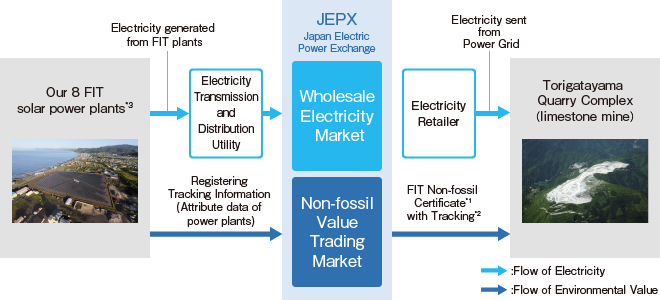Responding to Climate Change
- HOME
- Sustainability
- Environment
- Responding to Climate Change
- The Path Toward Achieving Carbon
Neutrality by FY2050 - CO2 Emissions in FY2024
- Measures to Reduce CO2 Emissions
The Path Toward Achieving Carbon Neutrality by FY2050
The social and economic impacts of climate change are becoming increasingly severe, and efforts to curb rising temperatures by transitioning to a decarbonized society are accelerating around the world. Our Sustainability Committee has taken the lead in measuring and promoting efforts to reduce CO2 emissions toward carbon neutrality.
CO2 Emissions in FY2024
In FY2024, domestic Scope 1 and 2 CO2 emissions totaled 223,000 t-CO2, a reduction of roughly 24,000 t-CO2 from the previous fiscal year. This is due to efforts such as reducing energy consumption, starting operation of new renewable power generation facilities for self-consumption, and substantial shift to renewable energy for purchased electricity through non-fossil certificates. Furthermore, periodic maintenance of lime kilns, resulting in decreased quicklime production, reduced non-energy-derived CO2 emissions by roughly 12,000 t-CO2.
Results of reducing CO2 emissions and goals from domestic Group*

- * Domestic (including Group companies) Scope 1 and Scope 2 emissions calculated using emissions factors based on the Act on Promotion of Global Warming Countermeasures.
Measures to Reduce CO2 Emissions
We are promoting several measures to successfully travel the path set out on our roadmap to carbon neutrality. The measures include our switch to renewable energy-derived electricity for the entirety of the purchased electricity for our head office in the Yusen Building in October 2022 as well as the following. We intend to continue to expedite our efforts to reduce CO2 emissions.
Introducing an Internal Carbon Pricing (ICP) System
In November 2022, we introduced an ICP system with the transaction price of 20,000 JPY/t-CO2 on capital investment across the Group (revised in June 2024). The ICP system encourages low-carbon investment and capital investment for decarbonized management by converting CO2 emissions associated with capital investment plans into a cost—an internal carbon price—to inform investment decisions. We will apply the ICP system to the installation of equipment—for example, energy-saving equipment and renewable power generation facilities for self-consumption—to promote capital investment that helps reduce CO2 emissions.
Installing Renewable Power Generation Facilities for Self-consumption
We are actively installing power generation facilities for self-consumption based on renewable energy sources (solar, wind, small-scale hydropower) at each Group location. In FY2023, we installed solar power generation systems at Hokkaido Lime Co., Ltd., and in FY2024, we installed them at Nippon Ball Valve Co., Ltd. and at four coastal facilities of the Torigatayama Quarry Complex. The total output across these three sites is approximately 240 kW. We are also continuing to explore similar installations at other locations.

In addition, we plan to install a solar power generation system for self-consumption with an output of approximately 1,500 kW in front of the submontane office at the Torigatayama Quarry Complex, with construction work underway for operation to commence in March 2026. After the operation begin, we expect to reduce CO2 by approximately 1,000 t-CO2*.
Progress of the construction of a solar power generation system in front of the submontane office at the Torigatayama Quarry Complex

-
*
Calculated based on the emission factor for purchased electricity for the Torigatayama Quarry Complex (for reporting in FY2024) under the Act on Promotion of Global Warming Countermeasures
Substantial Shift to Renewable Energy for Purchased Electricity through FIT Non-Fossil Certificates
In FY2023, we began purchasing FIT Non-Fossil Certificates*1 with tracking*2 for our FIT solar power plants*3 to key a substantial shift to renewable energy for a portion of purchased electricity for the Torigatayama Quarry Complex. We will continue to purchase FIT Non-Fossil Certificates and strengthen for CO2 emissions reductions.

-
*1:
FIT Non-Fossil Certificates
Certificates showing the environmental value of renewable energy and other non-fossil electricity sources and certifying the non-fossil value of electricity generated at renewable energy power plants under the FIT system -
*2:
Tracking
Attribute data of power plants (e.g. IDs, names, and installers of power generation facilities) -
*3:
FIT solar power plants
Solar power plants under the Feed-In Tariff (FIT) system for renewable energy that generate electricity that electricity utilities purchase for a fixed period of time at prices determined by the government
Other future initiatives
- Streamline facilities and introduce energy-saving technology
- Promote transition to EV in the company vehicle fleet
- Switch to biofuels for heavy machinery, use technological innovations to switch to electric heavy machinery, etc.
- Increase forest absorption by greening former mine sites and sedimentation sites at active mines
- Introduce new technology for CCUS and the like to reduce calcining limestone-derived CO2 in the future

